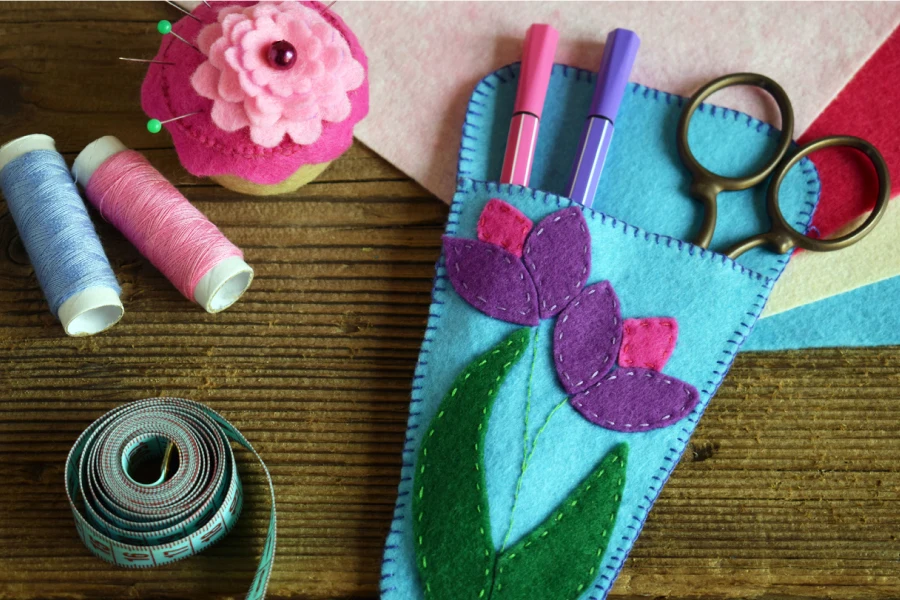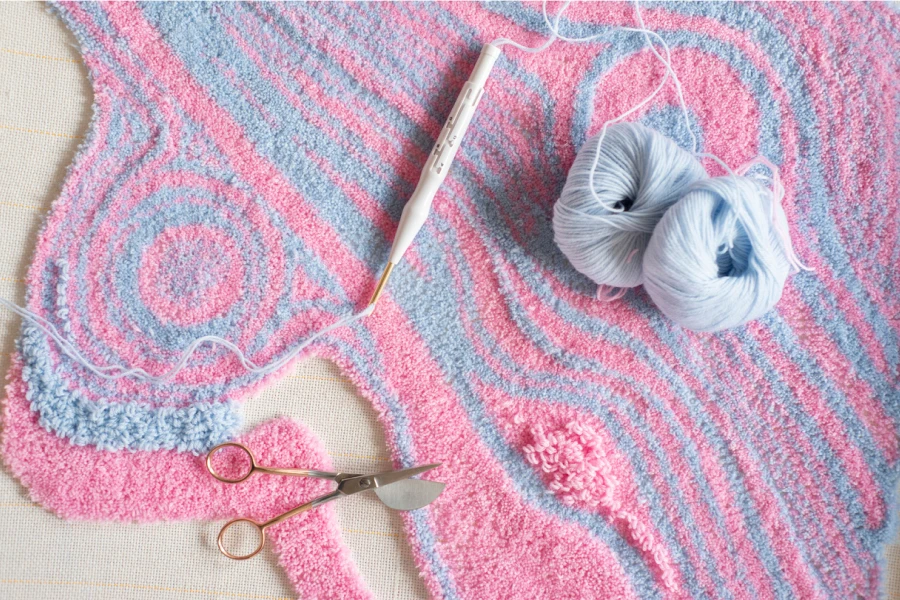Table of Contents
● The Evolution of Needlework Supplies: What’s New in 2024
● Trends Shaping the Future of the Needlework Industry
● Emerging Niches and Opportunities for Entrepreneurs
The Evolution of Needlework Supplies: What’s New in 2024
The needlework industry is undergoing a renaissance, driven by a blend of tradition and innovation. In 2024, this market is witnessing significant transformations, characterized by advanced technologies, evolving consumer preferences, and a strong emphasis on sustainability. According to Statista.com, the global market for needlework supplies is projected to grow by 4.3% annually, reflecting increased interest in craft and DIY activities.
Emerging Technologies in Needlework and Embroidery

Digital Embroidery Machines
The advent of digital embroidery machines has revolutionized the needlework industry. These machines offer precision, speed, and versatility, enabling users to create intricate designs effortlessly. The integration of software allows for easy customization and replication of patterns, catering to both hobbyists and professional embroiderers. According to Grand View Research, the market for digital embroidery machines is expected to reach $2.2 billion by 2026.
AI and Machine Learning
AI and machine learning are being harnessed to enhance design capabilities and streamline production processes. These technologies analyze consumer trends and preferences, providing valuable insights that help manufacturers and retailers stock the most sought-after products. Forbes notes that AI-driven personalization is set to increase sales by 15-20% in the craft supplies sector.
The Rise of Smart Needlework Tools and Apps
Technology has revolutionized the way crafters approach needlework. Smart needlework tools, such as the Cricut Maker and Brother ScanNCut, have made it easier than ever to create intricate designs and patterns. These cutting-edge machines can cut fabric, felt, and other materials with precision, allowing crafters to bring their digital designs to life. Additionally, a plethora of needlework apps, like Stitch Fiddle and KnitCompanion, have emerged, offering pattern libraries, project tracking, and virtual communities for crafters to connect and collaborate.
Trends Shaping the Future of the Needlework Industry
Shifts in Consumer Preferences for Craft Supplies

DIY Culture and Home Décor
The rise of the DIY culture has bolstered the demand for needlework supplies. Consumers are increasingly seeking unique, handcrafted items for home décor and personal use. According to Mintel, 67% of consumers prefer DIY projects as a form of relaxation and creativity. This trend is further supported by a survey conducted by the Association for Creative Industries (AFCI), which found that 63% of U.S. households participated in at least one crafting project in 2023, with needlework being among the top five most popular categories.
The growing interest in personalized and handmade home décor has also contributed to the surge in needlework supplies sales. A report by the Home Furnishings Association reveals that 45% of consumers are willing to pay a premium for custom-made or one-of-a-kind items. This preference for unique, handcrafted pieces has led to a 20% increase in the sales of needlework supplies for home décor projects, as reported by the Craft & Hobby Association (CHA).

Social Media Influence
Platforms like Instagram and Pinterest play a crucial role in shaping consumer preferences. Influencers and craft communities showcase innovative needlework projects, inspiring followers to try new techniques and purchase specific supplies. A recent Hootsuite report highlights that social media-driven purchases have increased by 25% in the craft supplies market. This trend is further evidenced by the rise of hashtags such as #embroidery and #crossstitch, which have collectively garnered over 50 million posts on Instagram.
Moreover, social media has become a primary source of inspiration and education for needlework enthusiasts. A study by the AFCI found that 78% of crafters turn to social media for project ideas and tutorials. This has led to a 30% increase in the sales of supplies featured in popular online tutorials and workshops.
Impact of Sustainable Practices on Needlework Materials

Eco-Friendly Yarns and Threads
Sustainability is a key trend in 2024, with eco-conscious consumers prioritizing environmentally friendly materials. Organic cotton, bamboo, and recycled polyester threads are gaining popularity. Textile Exchange reports a 30% increase in demand for sustainable fibers in the craft industry. Brands like DMC have responded to this trend by introducing eco-friendly embroidery floss made from 100% long-staple cotton, free from harmful chemicals. The rise of natural dyeing techniques, such as using plant-based dyes, has also gained popularity among needlework enthusiasts looking to reduce their environmental impact.
Reduced Waste and Recycling
Manufacturers are adopting practices to minimize waste and promote recycling. Some companies offer take-back programs for used materials, which are then repurposed or recycled. This not only appeals to green-minded consumers but also enhances brand loyalty.
Additionally, the emergence of “zero waste” needlework kits and patterns has gained traction among eco-conscious crafters. These kits provide precisely measured materials to minimize waste and often include instructions for repurposing scraps. The Zero Waste Craft Kit Company has seen a 50% year-over-year growth in sales since its launch in 2023, indicating the growing demand for sustainable crafting solutions.Emerging Niches and Opportunities for Entrepreneurs
Emerging Niches and Opportunities for Entrepreneurs
Fusion of Needlework with Other Crafts
The needlework industry presents a wealth of opportunities for entrepreneurs looking to carve out a niche in this thriving market. One emerging trend is the fusion of needlework with other crafts, such as resin art and woodworking. This cross-pollination of techniques has given rise to unique, hybrid products that appeal to a broader audience. For example, embroidered wooden jewelry and resin-encased cross-stitch designs have gained popularity on platforms like Etsy and Instagram. According to Craft Industry Alliance, 35% of crafters are interested in exploring multi-craft projects, indicating a significant potential for growth in this area.
Needlework Kits and Subscription Boxes
Another promising niche is the development of needlework kits and subscription boxes, which provide crafters with curated supplies and patterns on a regular basis. These products cater to both beginners and experienced crafters, offering convenience and inspiration. Cratejoy, a leading subscription box platform, reports that craft and DIY boxes have seen a 22% increase in sales over the past year. Entrepreneurs who can create unique, high-quality needlework kits and subscription boxes have the opportunity to tap into this growing market segment.
The Rise of Smart Needlework Products
Smart technology is making its way into needlework supplies, offering innovative solutions for crafters. Products like smart needles that track stitches and provide feedback via connected apps are becoming popular. These tools can help beginners learn proper techniques and allow experienced crafters to monitor their progress and optimize their work. [Business Wire] predicts that the smart needlework supplies market will grow by 18% annually through 2026, driven by increasing consumer demand for tech-enhanced crafting experiences. Entrepreneurs who can develop and market smart needlework products that offer tangible benefits to users will be well-positioned to succeed in this emerging niche.
Conclusion
In a word, the needlework industry in 2024 is characterized by innovation, sustainability, and evolving consumer preferences. The integration of advanced technologies, the growing demand for eco-friendly materials, and the emergence of new niches, such as the fusion of needlework with other crafts, needlework kits and subscription boxes, and smart needlework products, present exciting opportunities for entrepreneurs. As consumers continue to seek out creative outlets and personalized experiences, businesses that stay attuned to the latest trends, technologies, and consumer preferences will be well-positioned to succeed in this dynamic and rewarding market.




